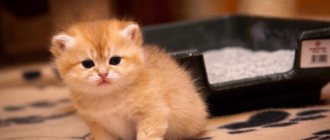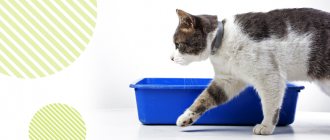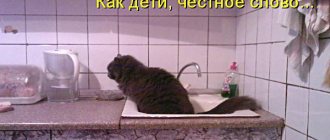Here are simple and working instructions that will help you quickly accustom your kitten to the litter box. Our guide will help you train your cat to go to the toilet in the right place in 3 days. Follow the recommendations and you will succeed. We also told you how you can train your cat to go to the toilet.
According to the table, select the correct filler. It should be environmentally friendly, not stain the kitten’s paws, not have a strong unpleasant odor, and should moderately retain odor.
| Type of filler | Block odor | Get your paws dirty | Harm to health | Has a smell |
| Silica gel | Fine | No | Dangerous if it enters the esophagus | No |
| Woody | Fine | No | No | Yes, a faint smell of pine |
| Clay | Fine | Dust gets wet and dirty | No | No |
| Mineral | Badly | Dust gets wet and dirty | No | No |
| Corn | Fine | small particles that can spread around the cat litter box | No | Yes |
| From paper waste | Badly | No | No | No |
Read our article with a detailed analysis of the choice of cat litter for the toilet.
Step-by-step instruction
Time to move on to the basic instructions, by following which you can teach your kitten a new, very useful habit - going to the toilet in the tray.
- Place the litter in a quiet and secluded area of your home. This should not be a passage or corridor, or areas near doors where people often walk. The ideal place is a bathroom or toilet, which is always open and the cat has access to the litter around the clock.
- The best time for the first trip to the new toilet will be 20-40 minutes after the kitten eats. Take it and place it with its paws directly into the tray with the filler.
- Pet him, say something kind, and then move away and let him look around and sniff the new place.
- If the kitten is ready, it will do all the necessary things. After the procedure is completely completed, praise him and cover the waste with a fresh layer of filler. Disposal of waste should not be done due to the importance of the smell of waste in the toilet area. Cats sense this smell and it is easier for them to find a place to go to the toilet. However, you cannot leave the toilet completely untouched. Kittens and adult cats are very picky about cleanliness and will not go into a dirty litter box.
Important!
Don't be too aggressive with the kitten. If you are unable to train him to use the litter box and he goes to the toilet in the wrong places, you should show him your dissatisfaction, but in an extremely friendly manner. At the moment of a mistake, go up to the kitten, lightly tap his nose with your finger and tell him what he is wrong about (this is how cats let their kittens know that they are wrong). And then take him to the tray and gently explain that this is where he needs to go to the toilet.
If the cat went past the toilet more than an hour ago, do not scold him, this will cause him misunderstanding. He won't remember what he did wrong. It is necessary to make it clear in a timely manner about the mistake made, but as we wrote above, do this in an extremely friendly manner - without shouting or physical violence.
Overlay systems
Veterinary stores sell designs that help you easily accustom a cat to the toilet in an apartment. They are produced for animals of all ages - for young kittens and adult cats:
- letter-quitter - a cover made by Chinese manufacturers, made of plastic; following the instructions, you can accustom a cat to the toilet in an apartment in 2 months;
- cat houses - the design is intended for adult animals that are 3-4 months old;
- anti-scratch – Russian-made pad, holes are made by hand.
Purchased pads will allow you to accustom your cat to using the toilet in an apartment in a short time, but after each cat litter you need to wipe them with delicate hygiene products to remove the smell of urine.
The younger the kitten, the better it can be trained.
We train a kitten at different ages
Select the age of your kitten/cat so we can make more relevant and actionable recommendations for your case.
Kitten up to 3 months
It is a little more difficult to train a kitten under 3 months of age to go to the toilet in a litter tray than an older individual. Learning at this age occurs more slowly. Most likely, you will spend not 3, but 7-10 days, but you can train any cat.
For small kittens, it is better to place the tray in the room where they spend the most time.
For very young kittens, it is important to place the litter tray in the bedroom or living room where the kitten spends the most time. Having trained to the toilet after 2-3 weeks, you can gradually move the tray to a place that is more secluded for the kitten and convenient for humans, for example, to the bathroom or toilet.
At the moments when the kitten begins to travel around the room on its own, try to pay close attention to its behavior. Transfer the kitten directly to the litter box as soon as you notice that he has stopped and is alert without moving. This is a sure sign that he is thinking about the toilet.
Kitten from 3 to 6 months
This is the most suitable age for litter box training. Just follow the instructions and you will succeed. And remember, lovingly caring for your pet is much more important than scolding him.
Cat from 6 months
The older the cat, the more difficult it is for him to learn new habits. You will need more time, endurance and patience for the kitten to learn to go to the right place. Also, 6 months is a good age for teaching a cat to go not only to the tray, but also to the toilet. But if the cat has not even gone to the litter box before, you need to start progressively - with basic things.
Subtleties of education
Sometimes the owner just needs to show the pet his displeasure. It should be expressed immediately at the moment the offense is committed (later it will be completely ineffective).
Allowed Methods
Permitted methods of influencing animals include:
- raising the tone towards the cat (with the obligatory pronunciation of its name);
- light tapping on the forehead (not painful, but quite unpleasant);
- stomping, clapping, hitting with a towel in close proximity to the animal.
Many Siamese cats begin to misbehave due to lack of attention from their owners. Love for pets is the best time-tested way to raise animals.
Prohibited tricks
Under no circumstances should you hit a cat, because an adult can easily injure the animal . The pain that a cat experiences is unlikely to help it draw the right conclusions about its behavior. Most likely, the pet will prefer to stay away from the offender, will stop responding to punishment, or will begin to show aggression in response.
Return to content
Why does the cat walk past the litter box?
There are times when a kitten or even an adult cat comes to the litter box, but goes to the toilet next to the litter box.
Main reasons:
- The kitten doesn't like the litter. It has an unpleasant odor, it can be either chemical or the smell of waste.
- If you don’t like the smell of the litter box itself, you may have washed it with a chemical or chlorine, which the kitten does not tolerate.
- The sides of the tray are too high and it is uncomfortable for the kitten to jump so high. The toilet must be accessible.
- Well, the kitten may simply be very young and not understand how to go to the toilet correctly. Continue training and over time his behavior will improve.
Eliminate the reasons, this should help. If not, contact your veterinarian; perhaps something is bothering the kitten.
Which filler to take
Now you can find special gel fillers that instantly absorb all moisture.
Kittens like to be dry, so they willingly go about their business in their potty. If there is no special signature on the packages “For kittens,” it is better to choose a filler that is not too coarse. This way it will be more convenient for the little paw to bury “traces of crimes.”
At first, you need to make sure that the baby does not try the filler on the tooth. This often happens, the owner should stop this action.
If it is absolutely impossible to buy filler, then you can use sand or torn newspaper. True, in this case the pot will not rid the room of the unpleasant smell, even if you clean it almost immediately. Numerous practices have already proven that you should not skimp on filler. Many of them are very inexpensive, it is spent sparingly, and the air in the room remains fresh, there is no dirt on the floors (like after a pot of sand), and the cats themselves prefer special fillers.
We train the cat to use the toilet
Wait until the kitten is 6 months old; after this age, the animal can safely perform the entire procedure in the toilet without using a tray. Also, make sure that the structure of your toilet is safe for the animal in case it accidentally falls into the water. If he can’t get out of the water easily enough, think about it: maybe you shouldn’t train your cat to use the toilet. Or use a special toilet nozzle sold in the store, more about it below.
- Start by moving the litter box to the toilet.
- As soon as the cat begins to constantly go to the right place, place a book or a stack of newspapers 2-3 cm high under the tray every 1-2 days in the first days, and then up to 5-8 cm per day.
- Thus, by about 10-15 days the tray will be at the height of the toilet. Leave the tray on the closed toilet lid for a couple of days.
- If the cat is used to going to the right place, periodically remove the tray, open the toilet lid and leave a little litter at the bottom (if provided for by the design).
- It will take some time for the cat to get used to the toilet and the absence of a tray. The training may take a week, or maybe 2-3 months. Be patient and don’t scold the cat for things that don’t work out right away. On the contrary, be polite and affectionate with him. He feels good and will be more willing to learn new things.
The corner of the litter box is an ideal place to place your cat's litter box. And for toilet training it is a mandatory and necessary condition.
Attention! Pay attention to special toilet attachments for cats, they are sold in pet stores. This is an easier and faster way to train your cat to use the toilet, and you will also protect him from accidentally falling into the water, since the grate blocks access to water. A person will have to remove the nozzle when going to the toilet, and when leaving the toilet, do not forget to put the nozzle back.
Where to start training a kitten to go to the toilet
You need to start toilet training your kitten on the day you bring the animal to your home. To do this, even before a small ball of hair appears in your apartment, you need to prepare a special cat potty and litter for it. These items must be selected correctly so that they suit the cat and do not cause a feeling of rejection in the animal. We'll look at how to do this below.
Buying a litter box for your pet
When choosing a litter box, you should not be guided by the criterion of what is cheaper, but rather give preference to a convenient, reliable cat litter box. The size of this device should be such that the cat can fit in it without any problems. Choose a stable tray with high sides so that your cat will not scatter its contents onto the floor. But for a small kitten, a device with low walls of 5-7 cm is suitable. If you do not want to use cat litter, then choose a model with a mesh. The following types of cat equipment are sold:
- One-piece plastic open tray of rectangular shape with low sides. It is perfect for a kitten. This pot is cheap and easy to use. It is easy to clean and does not take up much space at home. This device must be used together with special granules that absorb moisture well.
- Tray with mesh. Used without filler.
- A tray with high sides and an additional side attached to the edges. Cats love these patterns because they resemble boxes. This device is easy to wash and keep clean, but it requires more space than the devices described above.
- Closed tray in the form of a house. It looks very aesthetically pleasing and cats like it, but it is expensive.
- Automatically cleaning tray. This model is unique because it is a self-cleaning complex. This automatic device will save the cat owner from constantly cleaning up feces.
Filler selection
In the past, sand was used as cat litter. But this was extremely impractical and brought a lot of problems to cats and their owners. Convenient litters for cat potties are now sold that perfectly absorb odor and moisture. They are made from materials that are highly absorbent and safe for humans. The following fillers are suitable for cat litter:
- Woody. These are sawdust pressed into granules. This product is inexpensive, but it is able to effectively cope with its task. When the granules get wet, they disintegrate into sawdust to absorb moisture and odor.
- From grain, paper waste. They are produced in the form of small granules, which are made by pressing soybeans, bran, and paper.
- From corn. This is an environmentally friendly material that is harmless to people and cats. However, corn pellets weigh little, so cats can scatter them around the apartment.
- Made from minerals and clay. When exposed to moisture, pebbles made from these materials turn into lumps that are easy to remove.
- Zeolite, mineral. These substances perfectly absorb odor and moisture.
- Silica gel. This material is the best of all cat potty pellets because it needs to be poured in a small amount into the litter box and changed every 14-21 days. A good silica gel filler is produced under the “Crystal” brand.
Choosing the location of the cat litter box in the apartment
As a rule, many cat owners try to put the device for the animal’s needs in a secluded place, away from sight. Often the location of the tray is a toilet room or bath. But this is sometimes inconvenient for cats, especially if the door to these rooms is not always left open. It is better for your pet to place a potty in the corridor, because here this device will always be easily accessible to the animal.
To make it look aesthetically pleasing and not confuse guests, choose a house-shaped tray model. However, if you want to train your cat to use the toilet, then place the cat potty next to it. Then gradually place something under the cat's litter box until it is level with the toilet. Then the cat potty must be removed, and the cat, having returned to its usual place, will understand where it needs to defecate.
Nothing works out
Read our second article on this topic: How to stop a cat from shitting in the wrong place - you will learn several new recommendations that will help you solve this problem.
Let's give a few more tips to help you train a kitten or adult cat to use the litter box.
Once again, pay attention to your tray and filler. Use the most neutral filler possible, and do not wash the tray with special cleaning products so that it does not smell of chemicals. Let a special place smell better than the toilet, it is more pleasant for the cat than a chemical smell. And in choosing the ideal litter box, our article with a rating of cat litter boxes will help you: How to choose a litter box for a cat.
The process of training an adult cat to use a litter tray is not quick. Be more restrained in your emotions, let yourself understand that you and your cat may need up to a month so that he can fully switch to a new habit for him. During this entire time, according to the plan and instructions in the article, do everything to get the cat used to the new place. We described everything in the instructions above.
The kitten shits on the rug and carpets. A temporary remedy for unwanted trips to the toilet in inappropriate places can be the procedure of treating these places with the smell of citrus fruits - lemon, orange, pomelo and others. Cats do not like such smells and will not go to the toilet in this place anymore.
There is no time to train a kitten to use a litter box. At an early age, it is important to take the kitten to the litter tray quite often. But if you have little time, you are often at work or are absent for other reasons, try buying a cat toilet training spray at a pet store.
The kitten is eating litter, what should I do? There may be several reasons for this behavior, from a banal misunderstanding due to age, up to a lack of minerals. In any case, start with the following steps:
- Buy him some corn litter. It is harmless and absorbs moisture well. Once ingested, it dissolves easily as it is made from corn. The only negative is it's expensive. But you will only need it for the first time, until the kitten understands that there is no need to eat the litter.
- For the sake of prevention or in cases where the kitten eats too much litter, take it to the veterinarian. There, they may give recommendations on purchasing mineral complexes and vitamins.
- You can also cover the tray with a grid, which will block access to the filler itself. The mesh should be fine so that the kitten does not fall through and does not experience discomfort while on such a grid. However, this should be the last item on the list. Small kittens must be accustomed to the litter.
My cat goes to the toilet in flower pots. Cats often actually like the smell of the soil; this is a natural reaction. You can scare away due to two things:
- Cover the surface of the soil with small pebbles. This will reduce the smell from the soil and will not harm the plants.
- You can put orange or lemon peel on the surface. Cats don't like the smell of citrus fruits.
conclusions
Tray training a Siamese cat will require owners to be patient and understanding of the pet's needs. If you approach the learning process competently, you can expect to quickly consolidate the acquired skills. In this case, the owner will remain the best friend, and not someone from whom you should keep your distance.
Return to content
Reasons for possible difficulties
When developing the skill of defecating in the right place, difficulties sometimes arise. They can be caused by various reasons. Just watch your pet to understand why training is so difficult.
Sometimes it happens that an animal went to the toilet in the right place, and then suddenly stopped. In this case, you need to understand what causes this behavior and how to re-accustom an adult cat to the litter box.
Disease
The most dangerous and unpleasant reason for refusing to go to the toilet is illness. If something is bothering your pet, he may change his behavior in an attempt to let you know that something is hurting him.
In some cases, due to illness, he simply forgets where to go to the toilet, or this process causes him severe discomfort and pain. This may be urolithiasis, kidney failure or cystitis. If you notice changes in the animal's behavior, anxiety, lethargy, or other symptoms of the disease, you should contact your veterinarian. After the course of treatment, your pet will recover and, most likely, will return to its usual toilet.
Stress
Litter box refusal can also be caused by stress. It is worth considering that cats, like people, have different personalities and stress tolerance. Therefore, each requires a special approach. Limit the animal from stress as much as possible, be patient, do not punish the cat for mistakes - and very soon she will understand what you want from her.
It happens that changes in life circumstances cause anxiety in an animal. For example, a new person has appeared in the family or someone has died. In this case, try to devote as much time as possible to your pet. If you have a second cat, you should designate a litter tray for each pet.
New tray or new place
Cats are animals that do not tend to change their habits; they quickly become attached to their territory and certain places. Therefore, when changing the tray, a problem may arise such as refusal to go to the toilet in the usual place. What can we say about moving?
If you change the tray, sometimes you have to start training again - be prepared for this. If you are planning a move, make sure the new location has privacy areas for the cat and elevated areas for observation. The fewer reasons for stress the animal has, the better the adaptation will be and the fewer problems will arise with the toilet.
The period of sexual hunting
Sometimes difficulties are caused by the so-called mating season. It’s quite easy to check whether a cat leaves marks intentionally or whether there is another reason for his behavior. If the pet becomes more restless - it looks from the outside as if he is looking for something - and the animal urinates in small portions on a vertical surface, then we can definitely talk about the cat’s sexual activity. The solution is castration or regular mating with a cat.
Psychological reasons
There is an opinion that a cat can leave puddles out of spite, thus showing its stubbornness and discontent. Not all experts recognize this possibility - there are supporters of the theory that cats do not have consciousness, therefore, they do not know how to take revenge. In fact, many owners know that a cat can take a shit if it is offended - but almost immediately. Animals are definitely not capable of delaying revenge and serving it cold.
Top articles : World Tuna Day - May 2
If your pet is loved and caressed, but he still walks in the wrong place, first of all you need to rule out the disease. If everything is fine in this regard, you need to decide how to most gently accustom an adult cat to the litter box again, taking into account the identified reason: often puddles or piles become an attraction for the owner’s attention. A couple of examples:
The cat feels sad when left alone for a long time. The owner returning late finds a fragrant “gift” in an unexpected place. Getting a second pet will solve the problem.
The cat likes or doesn’t like something. If he wants to go for a walk, but they don’t let him in, he can shit under the door. Or there is a desired item in the closet, which means the cat can go near the door of this closet.
More complex causes are difficult to identify. Sometimes monitoring an animal takes several weeks, or even months. But patient owners cope with the problem, no matter how ingenious it may be.
Possible difficulties
If all the recommendations are followed, and the kitten does not go to the litter box, do not despair.
Pet ignores litter box
If the baby goes to the toilet everywhere, check that the rules for choosing the device, filler and place for the tray are followed. If an already accustomed kitten is mischievous, the advice is the same:
- the tray should be without traumatic elements, preferably without a mesh;
- filler – odorless;
- put it in a dark, secluded place so that the animal is not afraid of anyone.
If the recommendations are taken into account, the pet will be able to go to the toilet where it needs to be. The exception would be a kitten that is too small. A one-month-old baby will not understand what they want from him.
Timely training
It is advisable to accustom a kitten to the tray from an early age. From which one?
As soon as possible, ideally when he reaches four weeks.
Teaching a one-month-old kitten to order will be quite quick and easy.
According to the advice of veterinarians, this particular age limit is optimal for animals to learn new information and skills.
But this requires persistence on the part of the owner.
If the owner does not pay attention to the “dirty things” left in the corners of the apartment and silently removes them, then the pet will decide that this is in the order of things
If you took the baby from a nursery, where until now his mother was looking after him, then you should not flatter yourself with the hope that she instilled good behavior in him.
Best articles: Which natural resources are exhaustible and non-renewable?
As a rule, cats do not train their kittens to use the litter box. Kids can simply copy her actions.
And even if small pets managed to adopt some good habits during the time spent next to her, there is a high probability that the skills will be lost when the situation changes.
Even if the cat mother set an exceptionally good example for the baby, separation from her can lead to a complete loss of this experience.
When a kitten turns one month old and is immediately separated from its mother, it experiences stress, no matter how friendly its new owners are to it.
The baby is lost and often does not control his natural urges.
Here, new owners should show restraint and teach the kitten to go to the litter box on their own.
How long will it take? It all depends on your persistence and the character of the baby.










